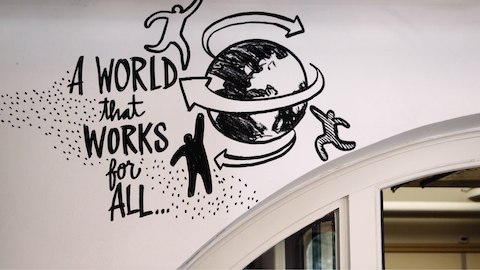Impact Hub and Akka Architects
Impact Hub in Amsterdam is a place-based change community which aims to impact societal issues through entrepreneurial action. Their aim is to make sure sustainable business is the business of the future.
Amsterdam
Download PDF (219 KB)
From Amsterdam to Johannesburg, Singapore to San Francisco, Impact Hub has evolved into a rapidly expanding, diverse global network of over 15,000+ members in 80+ locations.
Members from all over the world connect locally and globally on topics relevant to them. Impact Hub Amsterdam has a commitment to supporting the UN’s Sustainable Development Goals, which provide a road map for solving global challenges from climate change and rising inequalities to poverty and environmental degradation.
In January 2017, Impact Hub Amsterdam moved into their new home, the historic KIT building (Royal Tropical Institute) after the company outgrew their previous space.
Tatiana Glad, CEO of Impact Hub Amsterdam explains why the new co-working space is so important: “We see a general trend across the world towards collaboration. Working together collaboratively, across cultures, across mindsets, across sectors is one of our biggest challenges. So, I see co-working spaces as a pillar for the kind of change we need to see in the world.”

Impact Hub is a community-built space where people have co-ownership and can feel the whole space is theirs.
Stephanie Akkaoui Hughes is CEO of AKKA Architects. Her team designed the layout of the Impact Hub in Amsterdam, and have their offices there. She explains the thinking behind the design of the space: “The Impact Hub is a home for social entrepreneurs, and that meant we needed to look at all the different dynamics of work, of connecting, of socialising, of events, of meetings, that they would need to go through.”
Stephanie’s relationship with Herman Miller began many years ago, when she was developing her own vision of architecting interaction. The shared vision of the two companies meant that their relationship was built, not on specifying furniture, but their interest in how people work. She explains: “For a project like Impact Hub, it is on the edge of the future of work. It’s not your traditional company. So, it was a natural, organic relationship with Herman Miller.”
Tatiana continues: “The crux of our collaboration with Herman Miller was alignment of purpose. There is real alignment in terms of social, environmental and economic goals. We admire the rigour with which Herman Miller looks at its products, and how they try to make them as environmentally sustainable as possible. The other synergy we found was in our curiosity about what’s emerging about workplaces, workplaces of the future, how are workplaces reflecting health and wellbeing. We found Herman Miller’s research had statistics which justified what we were doing intuitively.”

As a home for social entrepreneurs, the space at Impact Hub needs to support all the different dynamics of work.
For the Impact Hub, the ownership of the space is very important. It is a community-built space where people have co-ownership and can feel the whole space is theirs. In addition, the stories which are told within the space are important.
Stephanie concludes: “How do we make sure that story becomes visible in the space. It is that energy, but it is also about how the space is used. We hold the space accountable to how it is proactively helping people do their work better than if they were doing it somewhere else.”